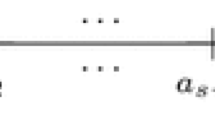Abstract
Analyzing repeated difference tests aims in significance testing for differences as well as in estimating the mean discrimination ability of the consumers. In addition to the average success probability, the proportion of consumers that may detect the difference between two products and therefore account for any increase of this probability is of interest. While some authors address the first two goals, for the latter one only an estimator directly linked to the average probability seems to be used. However, this may lead to unreasonable results. Therefore we propose a new approach based on multiple test theory. We define a suitable set of hypotheses that is closed under intersection. From this, we derive a series of hypotheses that may be sequentially tested while the overall significance level will not be violated. By means of this procedure we may determine a minimal number of assessors that must have perceived the difference between the products at least once in a while. From this, we can find a conservative lower bound for the proportion of perceivers within the consumers. In several examples, we give some insight into the properties of this new method and show that the knowledge about this lower bound might indeed be valuable for the investigator. Finally, an adaption of this approach for similarity tests will be proposed.
Similar content being viewed by others
References
Bi, J. andEnnis, D.M. (1999a)Beta-binomial tables for replicated difference and preference tests. Journal of Sensory Studies 14, 347–368.
Bi, J. andEnnis, D.M. (1999b)The power of sensory discrimination methods used in replicated difference and preference tests. Journal of Sensory Studies 14, 289–302.
Brockhoff, P.B. (2003)The statistical power of replications in difference tests. Food Quality and Preference 14, 405–417.
Brockhoff, P.B. andSchlich, P. (1998)Handling replications in discrimination tests. Food Quality and Preference 9, 303–312.
Ennis, D.M. andBi, J. (1998)The Beta-binomial model: accounting for inter-trial variation in replicated difference and preference tests. Journal of Sensory Studies 13, 389–412.
Hunter, E.A., Piggott, J.R. and Lee, M.K.Y. (2000) Analysis of discrimination tests. Agro-Industrie et Méthodes Statistiques, Pau, January 19–21, 2000.
Kunert, J. andMeyners, M. (1999)On the triangle test with replications. Food Quality and Preference 10, 477–482.
Marcus, R., Peritz, E. andGabriel, K.R. (1976)On closed testing procedures with special reference to ordered analysis of variance. Biometrika 63, 665–660.
Meyners, M. andBrockhoff, P.B. (2003)The design of replicated difference tests. Journal of Sensory Studies 18, 291–324.
Meyners, M. (2002) On the number of perceivers in a triangle test with replications. In: C. Duby and J.P. Cassar (eds.): Actes des 7èmes Journées Européennes Agro-Industrie et Méthodes Statistiques, Lille, January 16–18, 2002, 85–89.
Priso, H.E., Danzart, M. andHossenlopp, J. (1994)A statistical analysis of difference tests with replications. Journal of Sensory Studies 9, 121–130.
Schlich, P. (1993)Risk tables for discrimination tests. Food Quality and Preference 4, 141–151.
Author information
Authors and Affiliations
Corresponding author
Rights and permissions
About this article
Cite this article
Meyners, M. Deriving a lower bound for the proportion of perceivers in replicated difference tests by means of multiple test theory. Statistical Papers 46, 225–246 (2005). https://doi.org/10.1007/BF02762969
Received:
Revised:
Issue Date:
DOI: https://doi.org/10.1007/BF02762969




